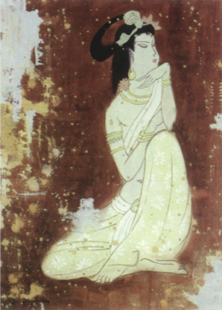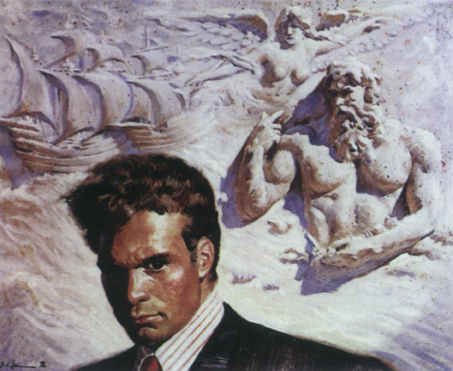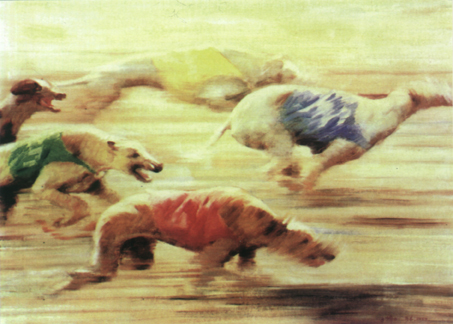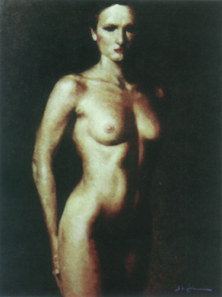 The Donghuang Beauty 敦煌美女.
LI RUIXIANG 李瑞祥 (°1941).
1985. Gouache on paper. 43.5 cm × 62.5 cm.
The Donghuang Beauty 敦煌美女.
LI RUIXIANG 李瑞祥 (°1941).
1985. Gouache on paper. 43.5 cm × 62.5 cm.
1.§1CHARACTERISTICS
During the last four and a half centuries the history of Macao has been described by the Chinese regarding Chinese matters, and by the Portuguese regarding Portuguese matters. Foreigners are usually unable to decipher Chinese historical documents and reciprocally the Chinese often find historical documents in Western languages inaccessible. Studying both types of document would reveal not only different aspects of the same question or event but also the expression of disparate feelings and arguments through their format and radically different norms, which can prove a considerable hindrance to the task of cataloguing and inventorying. This also explains why communication on these matters between Chinese and Westerners is difficult.
Li Ruixiang is not only a painter but also someone deeply interested in the history of Macao. This enthusiasm enabled his production of more than three hundred paintings during these last fourteen years with themes related to this history. Using a visual medium as a vehicle to reenact aspects of history suppresses the inevitable misunderstandings and loopholes of literary description. Besides bringing aesthetic pleasure and the appreciation of its technicalities painting is a more direct way to convey an event or a situation from written text to both Chinese and foreigners, be they culturally sophisticated or of a more straight forward frame of mind.
Generally Li Ruixiang paintings are rich and varied in content. They cover a broad period of time from the earlier days of Chinese culture in the Song and Yuan dynasties until the present. Their themes deal with a wide range of topics related to economy and commerce, religion and politics, culture, customs, landscapes and human figures. Though apparently representing unrelated themes, they are coherently united in reflecting a fulsome conception and an elaborate style.
These paintings depict many protagonists of the classical eras as well as contemporary times, among which are featured Chinese and Westerners, men and women, elders and children, emperors and saints, champions and heroines, folk people, merchants and even gamblers. These figures are shown in a wide range of situations and environments, wearing various garments and accessories, with a multitude of physiognomies and moods, all revealing characteristic vivacity.
 Pondering 思
LI RUIXIANG 李瑞祥 (°1941).
1986. Oil on canvas. 61.0 cm × 50.0 cm.
Pondering 思
LI RUIXIANG 李瑞祥 (°1941).
1986. Oil on canvas. 61.0 cm × 50.0 cm.
Li Ruixiang based his work in documented veracity but made use of his imagination, going beyond the factual representation traditionally conveyed by historical illustrations and official visual registers of heritage. Enticingly alive imagery prevails in paintings depicting the first inhabitants of Macao, the first commercial transactions between Chinese and Westerners, the first public Catholic indoctrination in the Middle Kingdom, the signing of the Sino-American treaty in the Mong-Ha• temple and many other events in the territory. As in the European and American painting tradition the images presented by Li Ruixiang offer the viewer a glimpse of the past and make an incursion into history.
His oil painting technique is characterized by massive texture and lush colouring. He reinvents the dull ambience of important historical events in imagery of vibrant tones. As in all consecrated pictorial representations, Li Ruixiang's works are impregnated with human feeling. His artistic dexterity adequately portrays heroes and citizens, ladies and whores, traders and players. Their expressive rendering, from their physical traits to their gestures and demeanor, reveals them as real and participating protagonists. In all the paintings related to Macao's history the settings of the action attest to the prestige and dignity of the occasion. The talent with which he controls the intensity and emotion of the moment are proof of his creative ability to portray respectfully the joint achievement of prosperity and peaceful coexistence between the Chinese and Portuguese in Macao — the example of a pact of friendship that should be preserved at all costs.
§2. MEANINGS
 Dog Race 赛狗
LI RUIXIANG 李瑞祥 (°1941).
1983. Oil on canvas. 80.0 cm × 60.0 cm.
Dog Race 赛狗
LI RUIXIANG 李瑞祥 (°1941).
1983. Oil on canvas. 80.0 cm × 60.0 cm.
The historical standpoint of these paintings derives from the continuously friendly relationships between the Chinese and Portuguese in Macao during the last four hundred and fifty years.
At present, when Macao is about to relinquish its Portuguese administration, Li Ruixiang paintings stand as commemorative mementoes and retrospective representations of Macao as much as celebrations of an ancient régime saluting a new era.
His strong beliefs made him work steadfastly on this corpus of historical paintings for many years. He did it as a solitary pioneer without government subsidies or private sponsorships. He strove in isolation, making progress independently, solely supported by his own beliefs. This personal determination shines out through this undoubted Chinese master's technical excellence. Very few foreign artists recorded Macao in paintings in the past and their precious testimony of contemporary Macao remains fragmentary, improvised and devoid of ultimate purpose. A systematic visual inventory of historical events such as Li Ruixiang's work is, indeed, extremely rare.
Oil painting, that originated in the West, was learned by the Chinese early on in the cultural exchange with foreign powers. Chinese pragmatism usually interprets foreign concepts and practices according to their moral relevance and usefulness within a national context. Close examination of Li Ruixiang's paintings reveals his highly creative skill, not only in the way he adopted Western concepts but also in the composition of the scenes, the overall structuring of the images and in the control and graduation of colours and brushstrokes.
One could claim his oil paintings to be the product of artistic and cultural interchange between China and the West; to be an expression of some of the spiritual wealth of the people of Macao.
§3. ASSOCIATION OF IDEAS
Macao is not a large Territory, nor its population enormous, but that notwithstanding that historical circumstances limited its output, it should be said that its artistic heritage is scarce. in relation to its long history. Most of the George Chinnery, Boser• [Auguste Borget] and Gao Jianfu• paintings are presently in the United Kingdom, France, Japan and Hong Kong, few remaining in Macao. One wonders what the fate of Li Ruixiang's paintings will be.
Since the signature of the Sino-Portuguese Joint Declaration on the future of Macao in 1987, the government of the Territory has paid particular attention to the cultural works produced locally during the transitional period; producing and publishing books, organizing exhibitions and concerts, supporting independent entities and associations, building a cultural centre, museums, monuments and statuary, promoting the teaching of the Portuguese language, developing education and founding and expanding higher education establishments. In these last few years, the government of Macao has contributed towards the culture of the Territory as much as Hong Kong to its territory, if not more.
Because exceptional works of art transmit positive feelings, elevate integrity and are eternal, they become historical landmarks and are praised repeatedly from generation to generation. For this reason the government of Macao searches continuously for quality artistic creation in a attempt to promote sound cultural values that express the nobility of truth and reject falsity.
The reproductions of Li Ruixiang's paintings illustrated here in the "Review of Culture" are a prelude to a forthcoming, more comprehensive album of his works being prepared by the Macao Foundation. The paintings with historical themes are also to be exhibited shortly at several venues in mainland China as well as appearing in a number of television documentaries. It is hoped that a small book with a chronological sequence of these paintings will be produced for educational purposes.
Last but not least, the author truly wishes that the artist will continue his efforts and achieve even greater successes.
Translated into English from a Portuguese adaptation of the Chinese original by: Carlos Figueiredo

Female Nude 女人体
LI RUIXIANG 李瑞祥 (°1941).
1989. Oil on canvas. 73.0 cm × 100.0 cm.
* Former Vice-President of the Instituto Cultural de Macau (Cultural Institute of Macao).
start p. 199
end p.